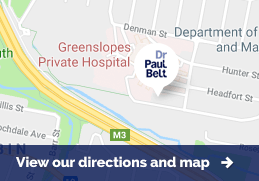The Procedure
This operation involves the removal of breast tissue and skin. The reduction in breast volume will result in smaller, lighter breasts and may lead to improvement in posture and relief of back, neck and shoulder strap pain. The procedure can also reduce the risk of rashes which form under the breasts (intertrigo).
The reduction in breast size and weight can result in a new lease of life allowing greater unrestricted activity. The procedure can also produce an uplift of the breasts so correcting any downward pointing of the nipples.
A breast reduction can also lead to an improvement in the shape of the breasts particularly with restoration of fullness to the upper pole of the breasts improving some of the loss of volume associated with ageing, weight loss and breast feeding.
Skin pattern and final scar
Circumareolar/Periareolar
This surgery can be performed simply with a circular scar running around the nipple areolar complex at the interface with the normal skin (Circumareolar or Peri areolar scar). This scar usually fades and is relatively inconspicuous.
Circumverical (lollypop)
A second option is to have a circular scar running around the nipple and a short vertical scar running below the nipple to the crease under the breast (circumvertical or “lollypop” scar).
Wise Pattern (anchor)
The third and more extensive skin excision results in a keyhole pattern (Wise pattern). This produces an “anchor” pattern whereby the scar runs around the nipple in a circular fashion and is connected with a vertical scar running from the nipple to the fold underneath the breast and small scar running in the groove underneath the breasts, which is hidden in the fold below the breasts.
Breast excision pattern
There are two common procedures employed.
Inferior Pedicle
The inferior pedicle technique preserves the nipple areolar complex on a pedicle of the breast tissue (parenchyma) based in the lower part of the breast. This technique has the advantage of potentially keeping breast sensation. It does however produce a more “boxy” shape. There is also the possibility of “bottoming out” with time.
Superomedial Pedicle
The second option uses a superomedial pedicle. The pedicle preserving the nipple and gland is based on the upper, inner part of the breast. This technique permits a “coning” of the breast and results in a better breast shape. The shape also is maintained more with time and doesn’t “bottom out”. Some studies have shown that there is no difference between these techniques with respect to nipple sensation after a period of approximately two years, but there is usually more sensory loss initially with the superomedial technique.
In some patients a breast reduction can also be performed using a combination of liposuction and skin excision (or mastopexy). This is a procedure usually reserved for older patients in whom the breast tissue (parenchyma) becomes replaced with fatty tissue (adipose tissue). It is also a safe procedure to use in patients who require a second breast reduction in whom the original technique is unknown. An ultrasound scan is usually performed prior to the surgery to calculate the percentage of the breast which is adipose tissue.

Complications and Risks
All Procedures have potential complications and risks. These can be divided into general complications and those specific to each procedure. The latter are listed in the FAQs below.
General complications include:
- Wound complications - bleeding, bruising, collections under the skin of blood (haematoma), pus (abscess), serous fluid (seroma), infection, wound breakdown, suture extrusion, sensory loss;
- Aesthetic complications - poor scars, stretched scars, raised scars (keloid or hypertrophic), contour irregularities, need for revisional procedure;
- Anaesthetic complications
FAQs
-
How do I decide on the size of my new breasts?
Dr Belt will discuss the ideal size you want to be during your two pre-operative visits. No guarantee of a specific cup size is made, as this is a relatively unscientific measurement. Different bra manufacturers can differ in the cup size by up to two breast sizes.
Your ideal size is influenced by your wishes, height, weight and body shape. The best results are obtained when you are as close to your ideal body weight as possible before the operation. Weight gain or loss after the surgery can affect the quality of the result.
Dr Belt uses a Vectra, which allows for a 3 dimensional photographic computer generated model to show the appearance of the existing breasts and also an expectation of their potential aesthetic outcome.
-
How is this surgery performed?
Options exist for the nature of the pattern of the skin excision which would dictate the final scar. In addition, patients can also choose the vascular pedicle on which the nipple is based which will influence the final outcome of the breast shape
This surgery is usually performed with the skin being removed in a keyhole pattern (“wise” pattern). This produces the “anchor” pattern whereby a scar runs around the nipple in a circular fashion and is connected to a vertical scar running from the nipple to the fold underneath the breast and a small scar runs in the groove underneath the breast.
Smaller reductions may be able to be achieved using only a circular scar around the nipple or alternatively a “lollypop” with a scar running around the nipple and a short vertical scar only. The breast tissue is usually removed and the nipple is preserved on a mound of tissue. This can either be based from below “the inferior pedicle” or from above “using the supero medial pedicle”.
The inferior pedicle technique is more likely to preserve the sensation to the nipple but does potentially produce a more 'boxy" shape. This also has the possibility of "bottoming out" with time.
The supero medial pedicle technique produces a better shape and a shape that is more likely to last. This is because the most gravity dependent part of the lower breast tissue is removed and this enables the sides (or lateral pillars) of the breast to be coned so producing a more natural rounded shape and restoring the volume to the upper pole of the breast. This also produces a shape that lasts more with time. There is a possibility that greater loss of sensation to the nipple may occur with this technique.
-
What are the potential risks?
The risks will be discussed with you in detail before you consent to the operation. The risks can be broken down into general risks associated with any operation, and those specific to breast reduction.
General operative risks include anaesthetic complications, bruising, bleeding, infection, wound breakdown and abnormal scarring.
Specific complications include: changes in sensation of the nipple and breast skin, asymmetry, bottoming out of the breast with time, interference with breast feeding, skin, fat or nipple necrosis (loss), and continued back, neck, shoulder and breast pain.
-
What costs are involved?
- Dr Belt’s surgical fee
- Assistant’s fee
- Theatre fee / day bed, and overnight bed if not a day case
- Specialist anaesthetists fee
- Costs of sports bra / crop top
Please contact Dr. Belt’s rooms and his staff can answer any questions you may have. A personalised quote and information can be sent to you regarding your procedure. -
What happens after the operation?
Most people will stay in a hospital overnight. A drain is usually inserted into each side. The drains are usually removed the following day prior to discharge from the hospital. You will be given a prescription for strong painkillers upon discharge from the hospital. You will be advised to wear a crop top for the first six weeks (day and night). I recommend that you plan a very quiet week immediately after your surgery and avoid driving for 2 weeks and vigorous exercise for 6 weeks.
The stitches are dissolvable and therefore don’t need removing. You will be seen regularly after the operation at one week, two weeks, six weeks and six and 12 months.














